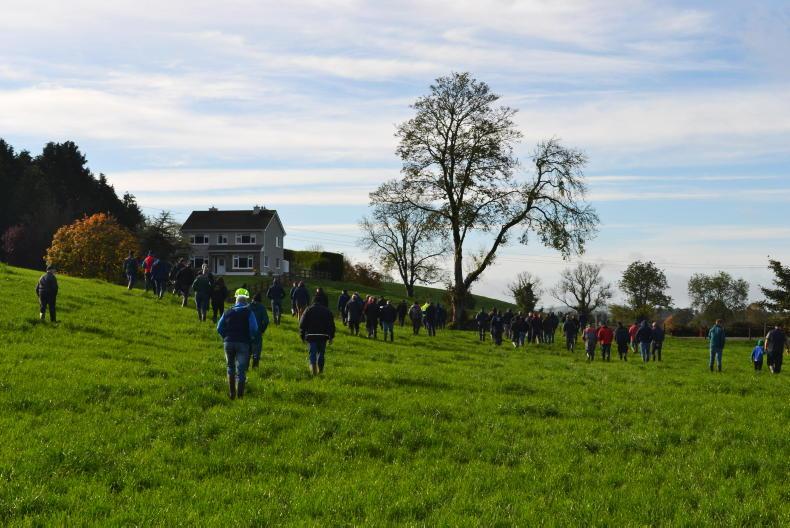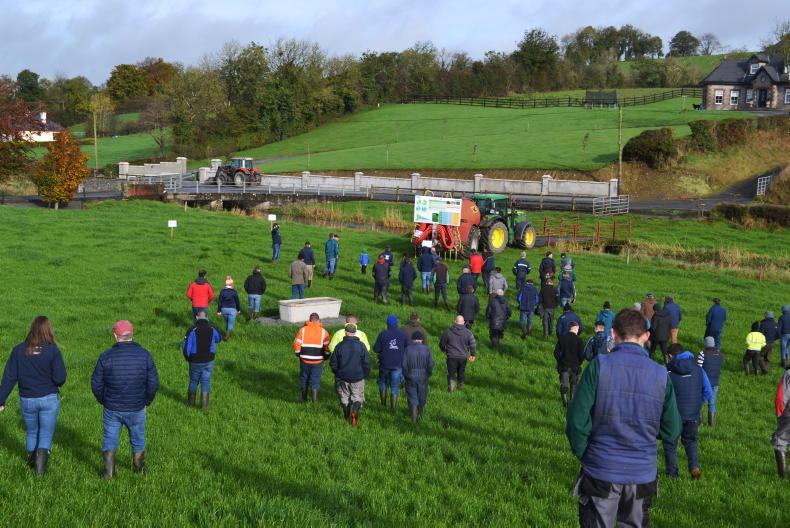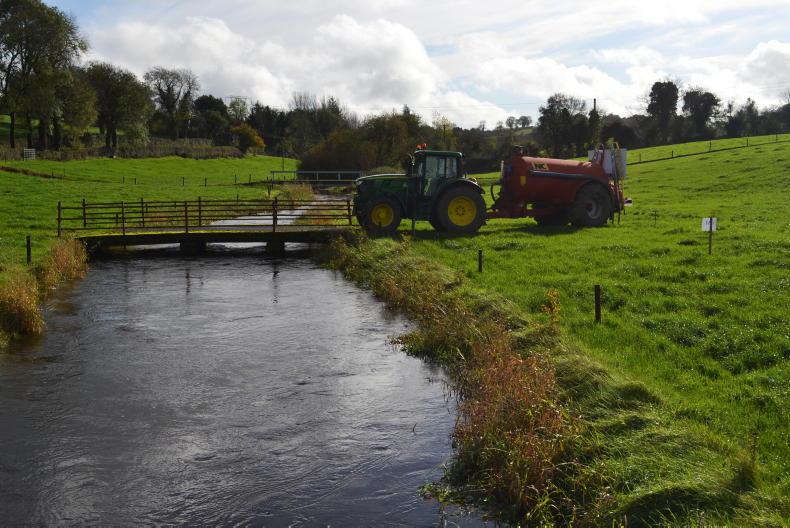Thomas and Alan Clarke are milking 145 cows in Killinkere, Co Cavan. In 2020, they joined the Signpost programme.
As part of the programme, they are making changes to how they manage the farm to improve sustainability, water quality, biodiversity and reduce their carbon footprint.
The Clarkes supply Lakeland Dairies and they produced 459kg of milk solids (MS) per cow from 784kg of concentrates in 2020.

Thomas and Alan Clarke Signpost farm event.
They farm on predominantly heavy soils. Milking 145 cows on a 59ha milking platform, the stocking rate is 2.5LU/ha. An out block a couple of miles away brings the total farm area to 97ha, with a total farm stocking rate of 2 LU/ha.
Up to Friday 29 October, there was no silage in the cows’ diet and there were 10 grazings left before cows would be housed full-time.
Alan and Thomas are the only two full-time labour units on the farm
The average farm cover was 703kg DM/ha. Cows are still milking well, doing 1.35kg MS/day at 15.3l/cow, fat at 4.58% and protein at 4.01%.
Alan and Thomas are the only two full-time labour units on the farm. They get a student in from Ballyhaise Agricultural College, who spends six weeks on the farm during the busiest part of the spring.
Throughout the year, they have a relief milker who does a number of milkings each week and covers holidays.
Breeding
Alan has put a huge effort into improving the breeding of the herd over the last 10 years. The EBI of the herd has increased from €95 in 2016 to €145 in 2021.
Coming from a British Friesian base with high fertility in 2021, the Clarkes had a 368-day calving interval and a six-week calving rate of 86%. After an 11-week breeding season in 2021, there is a 5.5% empty rate.
When selecting bulls, Alan’s main focus is on fat and protein percentages and the milk sub-index of the EBI.

Thomas and Alan Clarke Killinkere, Co Cavan, Signpost Programme farm event.
By focusing on these traits and grassland management, the herd performance has increased from just below 400kg MS/cow in 2016 to 459kg MS/cow in 2020.
In 2021, Alan decided to use sexed semen on the maiden heifers and a selection of high-EBI young cows in the herd. This was the first time that maiden heifers were bred to dairy AI, as in the past, there was a beef bull left off with the heifers.
AI was done for two weeks with the heifers, but without exact results or scanning, Alan reckons 60% to 65% of the heifers held to the sexed semen.
Around 33% of the cows received sexed semen and just under 50% were scanned in-calf to sexed semen.
Alan selected six sexed bulls in order to spread the risk, as the majority of his replacement heifer calves next year will be by these bulls.

Signpost Farm Event on Thomas and Alan Clarkes farm in Co Cavan. Rivers are fenced 1.5m back from the river bank.
Using sexed semen allowed Alan to select the bottom 30% of the cows in the herd and put them in-calf to a beef bull. He said that, overall, there was more dairy sexed semen straws used than dairy conventional straws in 2021.
Aoife Lynch, the Clarkes’ Teagasc adviser, said: “Only breeding replacements from the top cows in the herd will drive herd performance and, in turn, make the farm more sustainable and profitable.”
Reducing the carbon footprint
At the Clarkes’ Signpost farm event, the challenges faced by Irish agriculture and the requirement to reduce greenhouse gas emissions were discussed.
The Clarkes have made several changes on their farm to improve their sustainability and reduce their carbon footprint. The carbon footprint of their dairy enterprise is 0.94kg CO2/kg fat and protein corrected milk. This figure is 0.02kg CO2/kg below the average figure for similar dairy enterprises.

Alan Clarke discusses the technologies embraced on the farm to reduce their carbon footprint.
The carbon footprint of the farm is generated from the sustainability survey that all farmers have to complete as part of the Bord Bia audit process.
The Clarkes have had a 14% reduction in their carbon footprint between their last two Bord Bia audits. This has been achieved through adopting a number of technologies and farming practices, including:
Switching to using protected urea instead of CAN. Incorporation of clover into grass swards. The use of low emission slurry spreading technology. Improving biodiversity with over 500m of new hedgerows on the farm.Alan started grass measuring in 2016 and, since then, has increased grass production and utilisation. When he started measuring, the farm grew 11.5t DM/ha. Now, the growth has increased to 13tDM/ha.
“I started grass measuring with the discussion group in 2016. Before that, I thought it was a fool’s game, but now if I don’t do a grass walk every week, I feel lost. It helps keep everything right,” he says.
Alan expects to grow 12.7t DM/ha for 2021. A total of 206kg N/ha was spread, including slurry, 175kg of which was chemical nitrogen.
Focusing on improving his nitrogen use efficiency and reducing his carbon footprint, Alan switched to using protected urea and all slurry is spread using the dribble bar.
Over the last 10 years, there have been six sets of soil samples taken on the farm and a huge effort put in to getting the farm to optimal soil fertility. Soil samples in 2020 showed 75% of the farm was optimum for soil P and K index and soil pH.
The use of ground lime over the years means 100% of the farm is at optimum pH levels.
Grass measuring has allowed Alan to select what paddocks are underperforming and in need of reseeding. In recent years, he has started to focus on clover inclusion through reseeding.
Donal Patten from Ballyhaise Agricultural College said: “Knowing what fields have optimum soil fertility and targeting these with clover will ensure clover establishes successfully.”
Clover is very dependent on light getting to the base of the sward, so grazing at a cover of 800kg DM/ha for the first four grazings is very important
Donal also discussed the importance of managing clover paddocks to ensure the clover not only establishes, but also lasts in the sward.
Clover is very dependent on light getting to the base of the sward, so grazing at a cover of 800kg DM/ha for the first four grazings is very important.
As clover has the potential to fix up to 150kg N/ha/year, there are huge savings to be made both environmentally and economically.
In 2021, the Clarkes reseeded 10% of the platform and over-sowed one paddock with clover
As the management of new clover swards is difficult, Donal’s advice was to get clover in a reseed first and then look at over-sowing a maximum of 5% to 10% of the farm.
Any more than that is too difficult to manage on a commercial farm, says Donal.
In 2021, the Clarkes reseeded 10% of the platform and over-sowed one paddock with clover.
Their advice was to ensure clover had established correctly on these paddocks before moving to other paddocks next spring. A target of 20% to 25% clover must be reached before clover will fix enough N to maintain grass growth with reduced chemical N.
Thomas and Alan Clarke are milking 145 cows in Killinkere, Co Cavan. In 2020, they joined the Signpost programme.
As part of the programme, they are making changes to how they manage the farm to improve sustainability, water quality, biodiversity and reduce their carbon footprint.
The Clarkes supply Lakeland Dairies and they produced 459kg of milk solids (MS) per cow from 784kg of concentrates in 2020.

Thomas and Alan Clarke Signpost farm event.
They farm on predominantly heavy soils. Milking 145 cows on a 59ha milking platform, the stocking rate is 2.5LU/ha. An out block a couple of miles away brings the total farm area to 97ha, with a total farm stocking rate of 2 LU/ha.
Up to Friday 29 October, there was no silage in the cows’ diet and there were 10 grazings left before cows would be housed full-time.
Alan and Thomas are the only two full-time labour units on the farm
The average farm cover was 703kg DM/ha. Cows are still milking well, doing 1.35kg MS/day at 15.3l/cow, fat at 4.58% and protein at 4.01%.
Alan and Thomas are the only two full-time labour units on the farm. They get a student in from Ballyhaise Agricultural College, who spends six weeks on the farm during the busiest part of the spring.
Throughout the year, they have a relief milker who does a number of milkings each week and covers holidays.
Breeding
Alan has put a huge effort into improving the breeding of the herd over the last 10 years. The EBI of the herd has increased from €95 in 2016 to €145 in 2021.
Coming from a British Friesian base with high fertility in 2021, the Clarkes had a 368-day calving interval and a six-week calving rate of 86%. After an 11-week breeding season in 2021, there is a 5.5% empty rate.
When selecting bulls, Alan’s main focus is on fat and protein percentages and the milk sub-index of the EBI.

Thomas and Alan Clarke Killinkere, Co Cavan, Signpost Programme farm event.
By focusing on these traits and grassland management, the herd performance has increased from just below 400kg MS/cow in 2016 to 459kg MS/cow in 2020.
In 2021, Alan decided to use sexed semen on the maiden heifers and a selection of high-EBI young cows in the herd. This was the first time that maiden heifers were bred to dairy AI, as in the past, there was a beef bull left off with the heifers.
AI was done for two weeks with the heifers, but without exact results or scanning, Alan reckons 60% to 65% of the heifers held to the sexed semen.
Around 33% of the cows received sexed semen and just under 50% were scanned in-calf to sexed semen.
Alan selected six sexed bulls in order to spread the risk, as the majority of his replacement heifer calves next year will be by these bulls.

Signpost Farm Event on Thomas and Alan Clarkes farm in Co Cavan. Rivers are fenced 1.5m back from the river bank.
Using sexed semen allowed Alan to select the bottom 30% of the cows in the herd and put them in-calf to a beef bull. He said that, overall, there was more dairy sexed semen straws used than dairy conventional straws in 2021.
Aoife Lynch, the Clarkes’ Teagasc adviser, said: “Only breeding replacements from the top cows in the herd will drive herd performance and, in turn, make the farm more sustainable and profitable.”
Reducing the carbon footprint
At the Clarkes’ Signpost farm event, the challenges faced by Irish agriculture and the requirement to reduce greenhouse gas emissions were discussed.
The Clarkes have made several changes on their farm to improve their sustainability and reduce their carbon footprint. The carbon footprint of their dairy enterprise is 0.94kg CO2/kg fat and protein corrected milk. This figure is 0.02kg CO2/kg below the average figure for similar dairy enterprises.

Alan Clarke discusses the technologies embraced on the farm to reduce their carbon footprint.
The carbon footprint of the farm is generated from the sustainability survey that all farmers have to complete as part of the Bord Bia audit process.
The Clarkes have had a 14% reduction in their carbon footprint between their last two Bord Bia audits. This has been achieved through adopting a number of technologies and farming practices, including:
Switching to using protected urea instead of CAN. Incorporation of clover into grass swards. The use of low emission slurry spreading technology. Improving biodiversity with over 500m of new hedgerows on the farm.Alan started grass measuring in 2016 and, since then, has increased grass production and utilisation. When he started measuring, the farm grew 11.5t DM/ha. Now, the growth has increased to 13tDM/ha.
“I started grass measuring with the discussion group in 2016. Before that, I thought it was a fool’s game, but now if I don’t do a grass walk every week, I feel lost. It helps keep everything right,” he says.
Alan expects to grow 12.7t DM/ha for 2021. A total of 206kg N/ha was spread, including slurry, 175kg of which was chemical nitrogen.
Focusing on improving his nitrogen use efficiency and reducing his carbon footprint, Alan switched to using protected urea and all slurry is spread using the dribble bar.
Over the last 10 years, there have been six sets of soil samples taken on the farm and a huge effort put in to getting the farm to optimal soil fertility. Soil samples in 2020 showed 75% of the farm was optimum for soil P and K index and soil pH.
The use of ground lime over the years means 100% of the farm is at optimum pH levels.
Grass measuring has allowed Alan to select what paddocks are underperforming and in need of reseeding. In recent years, he has started to focus on clover inclusion through reseeding.
Donal Patten from Ballyhaise Agricultural College said: “Knowing what fields have optimum soil fertility and targeting these with clover will ensure clover establishes successfully.”
Clover is very dependent on light getting to the base of the sward, so grazing at a cover of 800kg DM/ha for the first four grazings is very important
Donal also discussed the importance of managing clover paddocks to ensure the clover not only establishes, but also lasts in the sward.
Clover is very dependent on light getting to the base of the sward, so grazing at a cover of 800kg DM/ha for the first four grazings is very important.
As clover has the potential to fix up to 150kg N/ha/year, there are huge savings to be made both environmentally and economically.
In 2021, the Clarkes reseeded 10% of the platform and over-sowed one paddock with clover
As the management of new clover swards is difficult, Donal’s advice was to get clover in a reseed first and then look at over-sowing a maximum of 5% to 10% of the farm.
Any more than that is too difficult to manage on a commercial farm, says Donal.
In 2021, the Clarkes reseeded 10% of the platform and over-sowed one paddock with clover.
Their advice was to ensure clover had established correctly on these paddocks before moving to other paddocks next spring. A target of 20% to 25% clover must be reached before clover will fix enough N to maintain grass growth with reduced chemical N.










 This is a subscriber-only article
This is a subscriber-only article










SHARING OPTIONS: